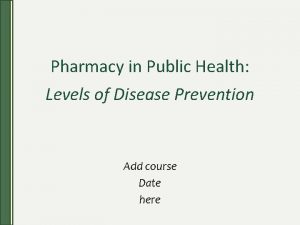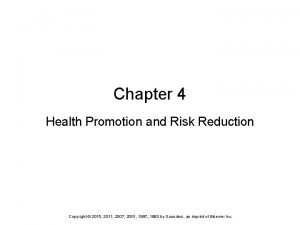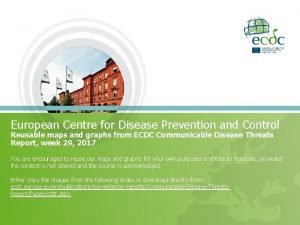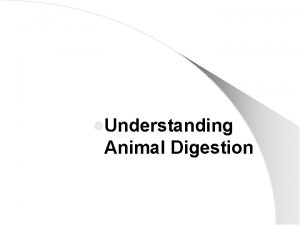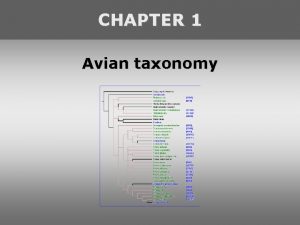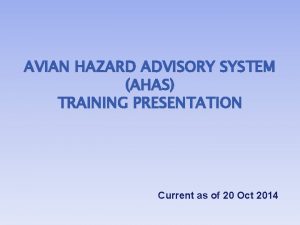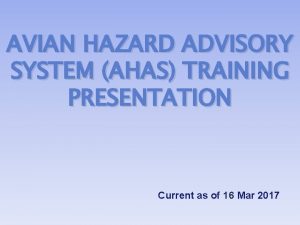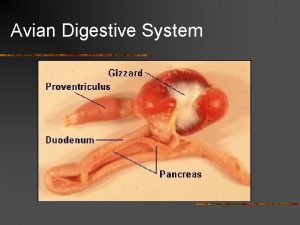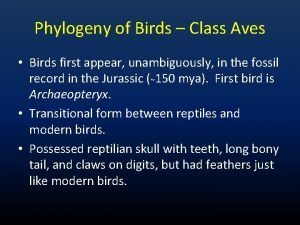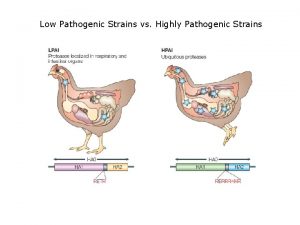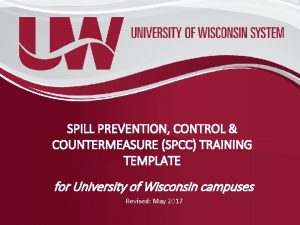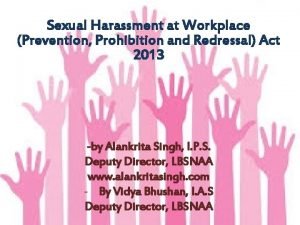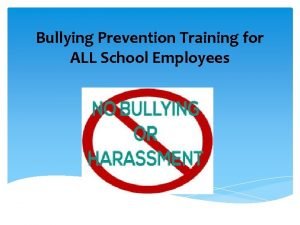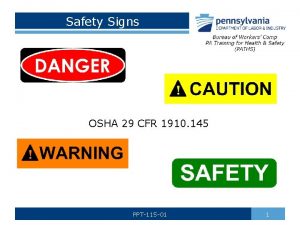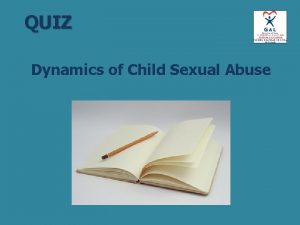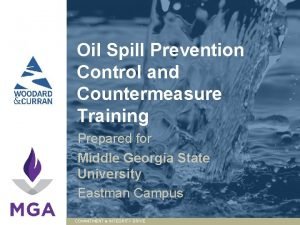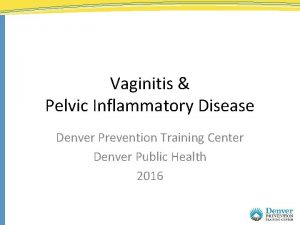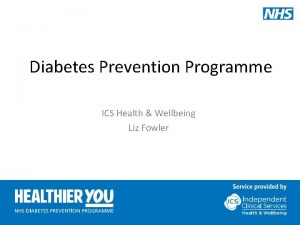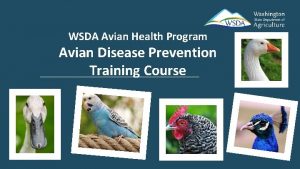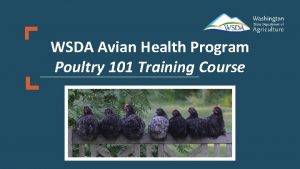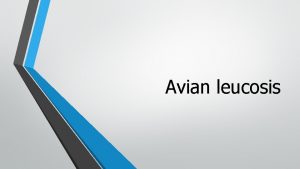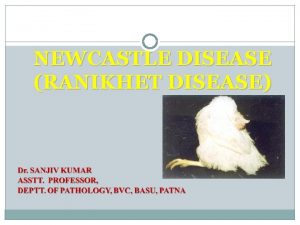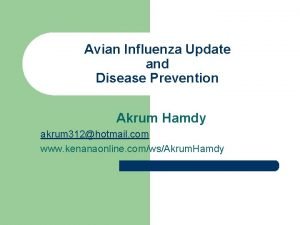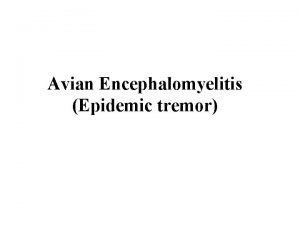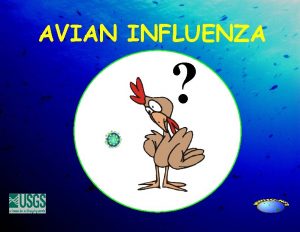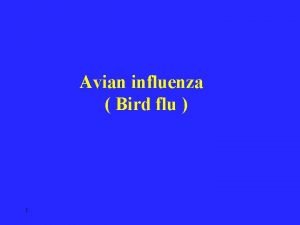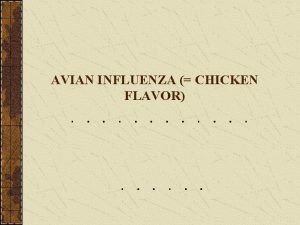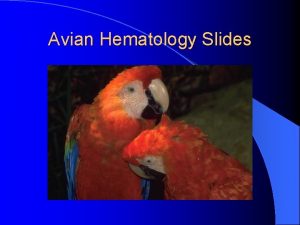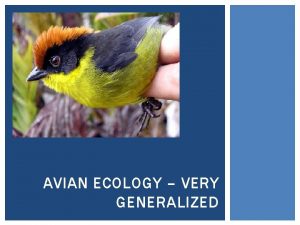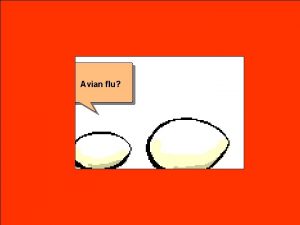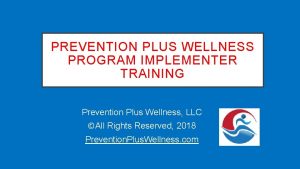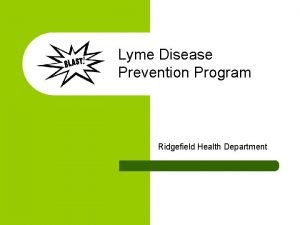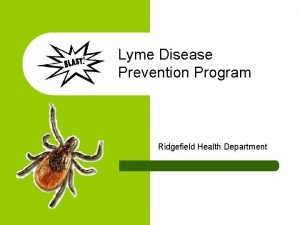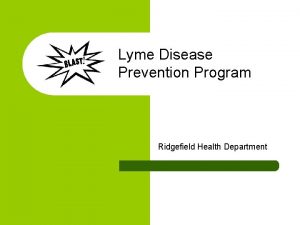WSDA Avian Health Program Avian Disease Prevention Training






























- Slides: 30

WSDA Avian Health Program Avian Disease Prevention Training Course

Goal The goal of this presentation is to provide poultry owners with a basic understanding of avian health terms, concepts, and biosecurity.

Terminology Pathogen: a bacterium, virus, fungus, parasite, or other agent able to cause disease. Biosecurity: actions taken to prevent the introduction and/or spread of diseases. Signs: evidence of illness that can be observed, such as diarrhea or coughing. Carrier: an animal chronically infected with a pathogen; may or may not appear ill. Contagious: type of disease caused by an organism that can be spread between animals. Transmission: spread of disease between hosts. Zoonotic: disease that can be transmitted between humans and animals.

What is a Bird Disease? Disease is a change from normal health, not including injury.

Zoonotic Diseases • Diseases shared by people and animals • Can be transmitted from animals to people and vice versa • Examples: § Salmonella (particular concern with chicks and children) § Avian influenza (some types) § Psitticosis § Erysipelas § Avian tuberculosis

Effects of Disease On Birds • Reduced egg production • Increased death loss • Decreased growth rate • Diminished animal welfare • Diminished activity and body functions (flying, roosting, foraging, etc. ) On Producers • Reduced farm profitability • Reduced product quality • Increased expenses • Restrictions on sale of birds • Damage to farm reputation • Reduced enjoyment of hobby

Infectious vs. Non-infectious Diseases Infectious diseases are contagious and spread between birds Examples: Avian influenza, virulent Newcastle disease, Marek’s disease Non-infectious diseases are not spread between birds Examples: Rickets, botulism, prolapse, egg peritonitis

How Do Diseases Spread? • Direct Contact: contact with a sick bird and/or its wastes, discharges, or secretions • Indirect Contact: contact with objects contaminated by a sick bird or its wastes, discharges, or secretions § Contaminated surfaces § Vectors (mosquitoes, lice, ticks) § Inhalation of aerosolized pathogens § Contaminated human hands, footwear, clothing § Contaminated cages and food and water bowls § Fomites (contaminated inanimate objects like show carpet squares, brushes, clippers, tires, etc. ) § Contaminated flies, wildlife, dogs, rodents, etc.

Recognizing Disease Conditions Disease changes may be subtle: • Know what “normal” or “healthy” looks like for your birds • Early phases of illness can be difficult to recognize • Examine birds daily for signs of illness such as sneezing, coughing, and reduced feed or water intake • Birds may appear healthy, but may be carrying disease agents or in early stage of illness

Infectious diseases are caused by: • Bacteria § Salmonella Pullorum-Typhoid § Mycoplasma gallisepticum • Viruses § Avian influenza § Marek’s disease (herpes) § Virulent Newcastle disease • Fungi § Aspergillosis • Parasites USDA APHIS Poultry Pathogens

Poultry Parasites • Internal § Nematodes (roundworms) § Protozoa (coccidia) • External § Lice § Mites http: //entnemdept. ufl. edu/creatures/livestock/poultry/chicken_mite. htm Ascarids. http: //niagabastomi. blogspot. com/2016/06/obati-ayamuntuk-parasit-cacing-sebelum. html

Signs of Illness • General signs • Respiratory system § Ruffled feathers § Sneezing • General symptomsloss § Weight § Coughing – Ruffled feathers § Decreased appetite § Nasal discharge – Weight loss § Drooping § Gasping for air – Decreased appetite wings – Drooping wings § Depressed behavior § Labored breathing – Depressed behavior § Failure to stand on perches § Elevated respiratory rate (pet birds) Digestive – • Failure to standsystem on perches birds § (pet Diarrhea § Vomiting feed or water § Crop or gizzard impaction

Signs of Illness • Reproductive system • Nervous system § Decreased egg production § Weakness • General symptoms § Malformed eggs § Circling – Ruffled feathers § Low fertility § Muscle tremors – Weight loss § Severe depression – Decreased appetite – Drooping wings § Twisting of head or neck – Depressed behavior § Lameness (pet birds) § Paralysis – Failure to stand on perches (pet birds

The Disease Triad Disease occurs when environmental, pathogen, and host factors align PATHOGEN FACTORS To reduce the likelihood of disease, address each factor: • Increase host resistance • Correct environmental conditions promoting disease • Reduce pathogen exposure k. HOST FACTORS ENVIRONMENTAL FACTORS

Increase Bird Resistance • Ensure proper nutrition § Provide adequate quantity and quality of food and water § Commercial diets more likely to meet birds’ needs § Monitor weight periodically § Feed pet birds more than just seeds– provide fruits, leafy vegetables, and sprouted seeds for a balanced diet § Give the proper diet for stage of life and production (e. g. layers) • Consult a veterinarian to discuss illnesses and treatments • Minimize bird stress

Minimize Bird Stress Control predators Control dust in pens Minimize changes in bird groups Limit visitors and caretaker changes Prevent ammonia fume accumulation Establish a clean and calm environment Maintain proper temperature for bird comfort • Provide toys and enrichment activities for pet birds • Give birds adequate space, ventilation, shade, and nutrition • •

Reduce Environmental Factors • • Provide excellent air quality via effective ventilation Emphasize sanitary conditions to decrease exposure to pathogens Prevent overcrowding Protect birds and their environment from flooding and wetness Maintain proper temperatures for bird comfort Control flies, vermin, etc. Prevent contact with wildlife and their habitat

Reduce Pathogen Factors • Vaccinate to reduce impact of pathogens of concern • Clean and disinfect regularly to minimize pathogen concentrations • Keep a closed flock to prevent import of new pathogens • Quarantine new/returning birds for 30 d. ; monitor for pathogens • Separate birds by age (older birds are a risk for younger birds) • Reduce pathogen dose and delay age of exposure so bird’s immune system is capable of responding and minimizing illness • Expose facilities and equipment to sunlight to kill pathogens

Medications and Vaccinations • Store medications and vaccines correctly § Check expiration dates and storage temperatures § Discard when expired • Follow instructions on vaccine or medication label • Vaccinate birds against diseases of concern in your area • Do not use unapproved medications without approval from your veterinarian • Antibiotics are not effective against viral diseases • Be aware of withholding times for meat and eggs

• Cleaning means removing all visible debris (manure, bedding, dirt, feed, feathers, etc. ) • Thoroughly clean all surfaces with soap and water • Rinse well and let dry if possible • Apply an appropriate disinfectant at the proper concentration for the recommended contact time • Rinse and let dry before using equipment or restocking premises with birds www. cfsph. iastate. edu Cleaning and Disinfection

Biosecurity • Actions taken to reduce the introduction and spread of diseases on a farm • Emphasis on PREVENTION vs treatment Benefits of Biosecurity: • Reduces pathogen numbers and likelihood of disease • Increases productivity and production • Decreases medication use, including antibiotics • Enhances reputation and flock value • Addresses animal welfare by reducing pain, sickness, and death

Biosecurity • Protect/separate birds from: § Wild waterfowl § Flies and rodents § Other animals § Visitors • If visitors have birds, do not let them near your birds • Quarantine new or returning birds for 30 days; watch for signs of illness • Isolate sick birds immediately; treat or euthanize as needed • If selling birds or eggs, meet customers off the farm • When possible, use surfaces able to be disinfected, instead of wood or dirt Did you know: SUNSHINE is an excellent disinfecting agent

Biosecurity • Safest to keep a closed coop (no new birds, no visitors, no shows) • Before entering a bird area: § Wear clean clothes and disinfected footwear § Wash hands before handling birds and between bird groups • Clean and disinfect bird living area: § Remove old litter, manure, and all other visible debris § Clean surfaces with soap and water; rinse and let dry § Apply an effective disinfectant at recommended concentration for recommended contact time; rinse and let dry before returning birds

Biosecurity Steps USDA APHIS • Use a hard roof or tarp to prevent wild birds from entering pen • Keep birds in a protected area; fence to prevent animals & people from entering • Minimize or exclude farm visitors • Vaccinate for diseases of concern • Keep wild waterfowl droppings out of coop • Prevent contamination of feed and water • If visitors come to your farm, provide boots or disposable booties • Clean and disinfect boots after use and/or dispose of disposable booties • Know signs of illness of various diseases & monitor birds closely

Biosecurity Steps continued • • • Clean & sanitize equipment & supplies properly Wear coveralls or specific clothing when working with birds; launder after use Work from youngest to oldest birds & from healthy to quarantined to sick Eliminate brush, weeds, grass, & debris around pens to reduce vermin habitat Keep feed in a sealed container to protect from pests & weather Stir or rake bedding/litter so manure is even throughout & moisture absorbed Ensure good sanitation through waste removal & cleaning Thoroughly clean & disinfect poultry housing, equipment, tools, etc. to reduce carryover of disease-causing agents between groups of birds Separate sick or dead birds from the flock immediately Do not allow contact between sick humans and poultry Do not house chickens with waterfowl or swine Purchase birds from NPIP certified flocks

Biosecurity at an Exhibition • Don’t borrow equipment and supplies from other bird owners unless thoroughly cleaned and disinfected before and after use • Broiler Disinfect hands before and after handling someone else's birds – • Provide Hybrids or combinations of differentbirds breedsfrom different premises solid barriers between • Developed for specific characteristics • – Grow Usefaster a clean holding towel and carpet square for each bird and larger • – Sterilize grooming instruments Large breast meat yield before and after each use – • More efficient feed conversion Quarantine birds returning from a show for 30 days – More disease resistance • • Used Dobynot allow direct contact between birds commercial broiler producing companies House waterfowl and eggs poultry separately • • Weakness: Do not lay as many as layer breeds • Consider wearing disposable gloves • Do not house birds with swine

Biosecurity for Pet Stores • Have customers wash hands before and after handling birds • Display birds behind glass barriers to prevent exposure to people carrying germs • Employees must wear clean clothes each day and wash hands before and after handling birds • Best if employees do not also own pet birds or poultry

Resources • WSDA Avian Health Program https: //agr. wa. gov/departments/animalslivestock-and-pets/avian-health • USDA Avian Health https: //www. aphis. usda. gov/aphis/ourfocus/animalhealth/animal-diseaseinformation/avian and https: //www. aphis. usda. gov/aphis/ourfocus/animalhealth/animal-diseaseinformation/avian/defend-the-flock-program • WADDL Avian Health and Food Safety Laboratory, Puyallup https: //waddl. vetmed. wsu. edu/avian • Extension Small and Backyard Poultry https: //poultry. extension. org • Poultryhub. org http: //www. poultryhub. org/ • U. S. Poultry and Egg Association https: //www. uspoultry. org/ • Biosecurity and Disinfection www. cfsph. iastate. edu

WSDA Avian Health Program Contact Info avhealth@agr. wa. gov

Contact WSDA WEB EMAIL TWITTER FACEBOOK PHONE YOUTUBE agr. wa. gov @WSDAgov 360 -902 -1878 ahealth@agr. wa. gov http: //tinyurl. com/WSDAFB Youtube. com/user/WSDAgov Images used in this presentation may not be reused without explicit written permission from the WSDA Communications Office
 Primary prevention secondary prevention tertiary prevention
Primary prevention secondary prevention tertiary prevention Health promotion and levels of disease prevention
Health promotion and levels of disease prevention Health promotion and levels of disease prevention
Health promotion and levels of disease prevention Puncture resistant container
Puncture resistant container Chapter 26 infectious disease prevention and control
Chapter 26 infectious disease prevention and control Chapter 19 disease transmission and infection prevention
Chapter 19 disease transmission and infection prevention European centre for disease prevention and control
European centre for disease prevention and control Chapter 19 disease transmission and infection prevention
Chapter 19 disease transmission and infection prevention Avian digestive system
Avian digestive system Avian taxonomy
Avian taxonomy Avian ku ethnicity
Avian ku ethnicity Precipitancy creates prodigality
Precipitancy creates prodigality Ahas birds
Ahas birds Bam ahas
Bam ahas Avian digestive system
Avian digestive system Dispersal definition
Dispersal definition Aves taxonomy
Aves taxonomy Enantiornithes
Enantiornithes Low pathogenic avian influenza
Low pathogenic avian influenza Bharathi viswanathan
Bharathi viswanathan Spill response steps
Spill response steps Alankrita singh ips
Alankrita singh ips Bullying prevention training
Bullying prevention training 29cfr1910 120
29cfr1910 120 Was it sexual abuse quiz
Was it sexual abuse quiz Spill prevention control & countermeasures training
Spill prevention control & countermeasures training Robbery awareness
Robbery awareness Army suicide prevention training
Army suicide prevention training Amsel criteria
Amsel criteria National programmes related to child health and welfare
National programmes related to child health and welfare Ics diabetes
Ics diabetes

